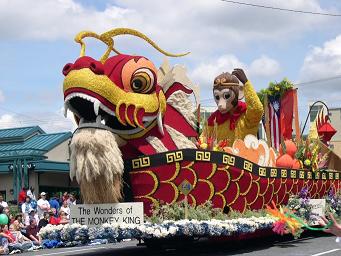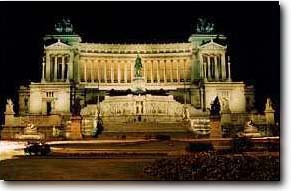|
|
 |
|
The Manifest Glory of Rome: The Roman Triumph |
|
written
by daw84 / 09.04.2005 |
|
|
| |
Conclusion |
| |
| |

|
| http://frenzieddaddy.com/gallery/
view_photo.php?set_albumName=
Rustifers_Main&id=dragonboat |
| Fig. 17 |
| A Modern Day Triumph: The Rose Parade |
| |
|
| |

|
| http://web.mit.edu/~mip/
www/photos/rome/ |
| Fig. 18 |
| Another Triumphal Arch: The Arch of Constantine |
| |
|
| |

|
| http://www.abcroma.com/
Monumento_i.asp?N=11 |
| Fig. 19 |
| Recent Monuments Incorporate Triumphal Imagery |
| |
|
| |

|
| http://www.hdg.de/eurovisionen/
html/popup/ku2_1a.html |
| Fig. 20 |
| The Roman Empire |
| |
|
The triumph was the largest, most significant event to occur in the life of Romans. It truly showed their glory, victory, power, and the eternal presence of the Roman Empire. For this reason, its use has been modified over time for many different purposes. In the Middle Ages, the Christian church used the imagery powerfully, shifting the focus of the triumph from that of conquest and military victory to that of Christ and the power of the Church. In the Renaissance, the imagery was used as a decoration because of its significance and its ability to weave together classical antiquity, mid-evil times and the renaissance. This marked a shift in the focus of the imagery from the church to the person for which it honored. Soon thereafter, the triumph degraded to solely a parade and was used casually in circuses and simple decoration.
The presence of the triumph can be clearly seen throughout Roman architecture today. Numerous grand monuments proudly display enormous statues of the magnificent triumphal chariot being drawn by four glorious steeds. The inscribed arch is a common motif used to mark the presence of a significant path in the lives of the Romans.
The triumph still stirs the hearts of all who encounter it today, just as it must have to the Romans of old. Its true significance of the triumph is encapsulated in the quote from Robert Payne’s The Roman Triumph.
The highest honor open to a Roman was the honor of a triumph: For this men fought, intrigued, suffered, and died. For the honor of a triumph immense sums of money were expended, innumerable people were needlessly killed, vast treasures were dissipated, and whole countries laid waste. The economy of Europe, Africa, and Asia was mercilessly disrupted, and a hundred cities and a hundred thousand towns were pillaged, so that the conquerors could return laden with plunder to Roma and show what they had accomplished. But, the same battles had to be fought over and over again, and when at last the Empire was falling into ruins, the emperors were still inscribing Pax Aeterna on their coins, when there was no peace, nor any hope of peace.
The triumph, in magnificent form, shows both the glory and the tragedy of the Roman Empire.
|
| |
|
| |
|
|
 |
|




